
32 minute read
EXECUTIVE Q&A
CANON'S FRANCIS A. MCMAHON Talking about this year's virtual thINK and Canon's plan for the future.







By Richard Romano & Adam Dewitz
We caught up with that printers need to understand the customer Francis A. McMahon, experience that Amazon is creating and how Executive Vice it’s going to affect us. President at Canon FM: Think of book printing. I don’t know Solutions America, about you, but I’m reading a lot more now. in the wake of the virtual thINK And there are a lot Ahead 2020 Conference to talk more books being about how Canon’s customers are produced for homefaring in the crisis, how Canon itself schooling. Book has responded, and how the crisis printers are thrivhas demonstrated the wisdom of the ing today, and that’s Grateful Dead lyric, “Once in a while a trend that’s going you get shown the light/In the strang- to continue. It’s est of places If you look at it right.” on-demand, it’s
WhatTheyThink: At the start of the shorter-run, and year, everybody was looking toward a Francis A. it’s done digitally. positive 2020, printing shipments were McMahon The transactional up—and then March happened. How have side is suffering Canon’s customers been reacting to the crisis? a bit. Projections
Francis McMahon: I talk to a minimum from Keypoint of two customers a day, and probably a max Intelligence and I.T. Strategies, based on of fi ve a day, and people are really looking at what we are seeing, are a little pessimisprinting differently. They want shorter runs— tic. We’re not seeing declines of 20% and and they don’t just want print-on-demand, 30% page volume, but just under 10%, and they want super-fast print-on-demand. And a majority of that is transactional. People they’re not as quality-sensitive anymore. aren’t going to doctors as much. There aren’t It’s changing the value of what print is to the as many automobile accidents because people that are buying it. For the marketer people aren’t driving as much. So there and the advertising agency, they’re saying, aren’t as many insurance claims and claim “Wow. If I can get a higher return, and I can printing is much lower. On the transactional turn it around very fast, and I can do shorter side, we also have to be thinking about paper runs, that’s a good thing.” prices going up, what’s happening with the
WTT: That’s really the Amazon effect U.S. Postal Service and postal rates and the coming to the printing industry. We want a impact that will have on our industry. If the really fast, streamlined order system so we total cost continues to go up, more corpocan even make purchases from our phones. rations are going to start demanding more This is the year where it’s becoming clearer e-communications. We have to help people
understand the value of print communications in the mix.
I think we’re in for some challenging times in the next two years—not bad, just challenging. The market’s not going to be as big as it was in 2017, ’18 or ’19, and I think it’s going to take until 2023 to get back to those levels. We all needed to be woken up; not just in our industry, but humankind just needed to wake up, and that’s not a political statement. We live in a very prosperous country and prosperous world, for the most part, and we’ve just taken everything for granted. I think people get complacent and they don’t think as strategically or as innovatively as they could because they’re comfortable. The only way to force great change and create great opportunities is to be taken out of your element. Unfortunately, it’s happening in the form of a worldwide disaster. But for the printing industry, it’s showing us that the old ways of doing things need to evolve.
WTT: Canon has been very aggressive in continuing to launch products this year. How was that strategy developed and how is it playing out?
FM: The important thing is, there’s the virus and it’s a really bad situation and we need to be sensitive. At the same time, we have a responsibility to the industry to keep it going. We made promises to a lot of customers who made decisions months ago to wait until these products came out, and some of those businesses were counting on us to get our new products to them so they could start pursuing new markets or replacing older equipment. We felt a real need to stay on track. We moved forward with the Prostream 1800 because we had made commitments to customers that they would get one in a certain period of time. Then there are upgrades; there are a lot of 1000s out there, and if customers want them to run faster—and the return on investment is much faster when you can produce more—they needed upgrades. So the driver behind the ProStream 1800 launch



was that our customers needed it, and we will always do what is right for our customers.
WTT: You also launched the varioPRINT iX.
FM: We had a lot of customers that were waiting to get the next generation so they could have sheetfed inkjet with the same type of running costs, but more fl exibility on paper and higher image quality. We felt a real need to get that out. Going back to the changes in the printing industry, this is going to be one of the presses that helps our industry get to the future successfully.
WTT: You have both continuous-feed and sheetfed units. Where are people making the bigger investment?
FM: Continuous-feed is going to remain an important product for years to come, but many of us believe that sheetfed is the dominant product: multiple substrates, being able to print more jobs because you’re not doing roll changes, super-fast turnarounds. We sold more of our sheetfed devices than we ever had in January to June compared to any other year
WTT: Canon has been doing R&D in labels and packaging and developing concepts under the LabelStream brand. Is there any update on Canon’s entry into the packaging market?
FM: Not at this point, but it’s a growing opportunity, no question. Our infrastructure is set up to support the commercial, transactional, book and direct mail spaces. We’re the market share leader in production inkjet and we’ve got a really profi table business. I view labels and packaging as a different business, not necessarily outside of production printing, but it’s a whole other piece that requires the right infrastructure to support it and go to market. We’ve got our eye on it and you’ll hear soon about what we’re going to do.
WTT: I want to kind of shift gears to the thINK Conference, which went virtual this year. Talk about the reaction to the event, what you’re building with thINK beyond just a



Read More… Find article at PrintingNews. com/21143880
PROCESS CREATORS VS. PROCESS FOLLOWERS
When print busi- informs you that you will be more effi nesses buy soft- cient, win more business and increase Manage ware, you are your profits from purchasing this tool. your process sold on the All of that is possible. It does happen. to better return-oninvestment (ROI) of the software tool. It’s never guaranteed, and the software is not the most important component in manage your The sales process includes references making all those good things happen. In business. to other printers who have completely a world that is addicted to the idea that revolutionized their business with the technology can fix everything, it seems purchase of this tool. The sales process like a controversial statement.

The most important component of your business is having people who are good at process creation. What do I mean by process creation? We can really simplify work down to just two kinds: process creation and process adherence/execution. Your business, as it runs today, is a collection of processes that are executed over and over everyday by your employees. Many of these are “informal processes” that exist only in your employees’ heads and they are executed based on memory. So when there is turnover or expansion, undocumented processes get passed down verbally, if at all.
A business’s ability to execute is really about the processes it uses to get work done. What are your processes? Do they work for you? Do they work when your best CSR goes out on maternity leave? Do they work when your top press operator breaks their leg skateboarding? Processes that rely on your best humans are people-centered processes; every business has some of them. Sales is a very people-centered process but even there you can create a methodology for guiding a prospect through the sales process of becoming a customer.
I want to talk about your employees who can create, reinvent and reimagine processes. These are the employees that are absolutely critical to getting the ROI out of those software purchases.
I like to joke about businesses who have terrible customer service (which is usually a process problem). My joke usually goes something like this: “Did they wake up this morning and decide they were going to start renting cars, making it up from scratch?” I

swear sometimes when I walk up to rental car counters, it feels like they are doing this thing that is their core business for the first time. In other businesses, you walk in and you feel like someone thought about every single move every person is doing to get your product or service into your hands as quickly as possible. I think about the In-N-Out Burger drive-thru (a fast food restaurant on the West Coast)—you see lines 20+ cars deep and you still get in line because you know they are doing everything possible to move that line as fast as possible.
When do you pay attention to processes? You might not be aware of this, but you probably are talking about processes daily. When things go wrong in your business, you might call a meeting (back when we could meet in person). Now you call a virtual meeting. These meetings typically jump right to solutions. How do we solve this challenge? Or, what do we do to prevent this human mistake from happening again? If there’s a process creator in the room (they are both born and made), they are focused on understanding the process as it is supposed to work now. They stay in the challenge. Nobody in the room knows enough to solve the problem yet because a process breakdown usually involves multiple layers of issues. It is almost never the obvious first guess. If there are no process creators in the room, patches get added to an already broken process. This continues for years; patches upon patches upon patches of “solutions” that weren’t
Jennifer Matt writes, speaks, and consults with printers worldwide who realize their ability to leverage software is critical to their success in the Information Age. Read More… Find article at PrintingNews. com/21143771
properly thought through or that cause additional issues up or downstream.
Process is boring to a lot of people. In fact, many people are repulsed by it. I tried to get a leadership group at a printer to walk through the path a job takes in their shop from estimate to shipment. Key leaders could not stay for the whole meeting. It was too uncomfortable. This is the primary process in their business; as the number of Post-It Notes increased on the table and the number of discrepancies between team members mounted, the room had a noticeable tension. The core process of the business was unclear, inefficient and error-prone. It’s a process-mapping exercise, not a place to blame anyone. How do you fix something you haven’t yet defined?
Most businesses don’t give people the time and space to define their processes. You don’t staff your business for your employees to have a lot of free time. Process definition isn’t required everyday and it should not be done by everyone. In fact, asking non-process creators to create processes is a recipe for disaster. You have to understand who is a process creator and who is a process executor. Don’t mix the two. Some people can think about the flow of the business, others are far more comfortable “in the flow of the business.”
Here’s a very brief description of how I think about processes. First of all, you have to believe and understand that your whole business is a set of processes. For example, we recently decided to offer professional services on a software subscription product. Our steps in defining the process looked something like this: 1. Write a rough draft of the end-to-end process, led by a process creator who is getting input from all the process 2.
3.
executors - the people who will be doing the tasks.
Iterate on this draft for at least a few days. Ideas get better when they are allowed to bake.
Because this process is going to be run over and over, we put the process into a tool called
Process.st, which allows you to create a process template and run checklists each time the process is run. 4. We ran the first checklist against the first project. 5. We had a bunch of things we forgot or didn’t optimize, which we noted during the first process. 6. We iterated the process. 7. We ran it again. 8. We iterated again. 9. We then handed it off the executors - not the process creators. 10. They ran it once and had additional questions. 11. We iterated. 12. Now we’ve run it like 30+ times and have only made one or two additional changes. 13. This process is boring. It just happens and everyone knows how to do it and who should be doing what.
That seems like a lot of work, but now this process runs daily, and I’m not involved. It’s boring. It just happens without mistakes or human errors. Once in a while an exception will be thrown and we’ll reconvene and look at what we need to do to change the process. In the middle of all this we added another resource. There was no training. We simply asked them to follow the documented process; she had a co-pilot for their first project and then was on her own after that. ●







For more information, visit PrintingNews.com/10004777
THE DIGITAL
TRADE PRINTER A new approach to an old idea


By Frank Romano
Back in the day, trade printers would gang printed jobs in full color from a number of small commercial printers onto one




large sheet. This cut cost and allowed small printers to offer color-printed jobs to their customers. In many cases, these trade printers were also called gang printers. They advertised extensively in industry trade publications. This was in the day when most small printers had black and white offset duplicators and 4-up or large color presses were
Greg Wallace, beyond their Harvard Pinnacle reach. Full-
Group Owner color printing required color separations, exacting pre-press and highly skilled staff. Small and quick printers had high school kids.
Color printing on an offset duplicator often consisted of a
Townsend T-Head which could print a spot color. It was not until the advent of the digital color printer in 1993 that color printing was generally available. It then took a while for the equipment to become affordable to the small and medium printing company. Today, almost every printer offers full-color production printing routinely. And offset duplicators are now in museums.
Enter HPG. Harvard Pinnacle Group in Waltham, Mass. is a digital trade printer. They began in Harvard, Mass. on Pinnacle Road and hence the name. Owner Greg Wallace started the company as a Macintosh training center, and his need for training materials moved him into printing. The company was born digital and has stayed digital.
The HPG equipment complement consists of six digital printers and 14 fi nishing systems. Those digital printers include Oki, Konica Minolta and Xerox Iridesse. There are no direct or end user customers. HPG only prints for the trade and sells to the trade. Its customers are other printers.
Why is there still a need for the trade printer? Certainly, every small or quick printer already has a digital printing device or two or more. Perhaps one is black and white and the other is full color. But there is a bewildering variety of systems out there, with extended gamut capability, special spot colors, a variety of
fi nishing options and much more. Let us not forget that there are still trade printers with 6-color or more offset presses.
Way back when, I did a consulting gig for a New England business forms company. We ganged a gazillion business cards on the fi lm output from an CRT phototypesetter so as to burn one plate. Some of the early online printing services began as gang printers by organizing multiple jobs on one large sheet. Today, short runs are the norm, and digital printing is the right technology at the right time.
The trade printer is an extension of another printer’s business. Trade printers stay on top of the technology and thus allow the small printer (or any size printer) to offer new services without committing to new equipment.
I once read “Pierre DuPont and the Making of the Modern Corporation” and learned that a company can apply a buy rather than make approach. This negates large investments in capability until the amount of outside purchases reaches critical mass. Then the company can make the investment in equipment or infrastructure. Trade printers let you build a business and then invest in new capacity when the revenue justifi es it.
The HPG fi nishing equipment is even more interesting. HPG acts as a dealer for Duplo and Challenge which makes the Waltham facility both a production hub and a demonstration center. HPG’s business today is


about half and half, digital trade printing and fi nishing equipment sales.
“Many dealers do not have the equipment they sell in their demo rooms, so they are selling by using the data and spec sheets,” Wallace said. “HPG uses the equipment it sells in our Digital Print Production Center for actual production jobs that we get from printers, brokers and trade companies.”
Dealers usually use their equipment vendors to demo equipment or have “canned” demonstrations. HPG welcomes having potential clients use actual production jobs to test fi nishing equipment. And the HPG Digital Print Production Center also acts as a production backup for their customers. They know what works, what doesn’t work and how to make it work.
Equipment never breaks until you use it. Sometimes HPG customers are in the middle of a production job that they can’t fi nish until their equipment is fi xed. HPG has a “We’ve Got Your Back” service program where they invite clients to come into the Digital Print Production Center to use the HPG facility or send their job and HPG will fi nish it for them.
The variety of HPG work is staggering. Displays throughout the building show printing

on almost every substrate, with special effects that draw attention. From small brochures to giant signs, HPG stays on top of the technology to meet its customers’—and by extension their customers’—needs.
“It’s the value-add that matters,” Wallace said. Read More…
HPG can Find article at add foiling, PrintingNews. gold/silver com/21143769 imprinting and other special effects. And these features get attention.
More importantly, workfl ow matters. HPG operates with a small contingent of staff, and this is possible because of workfl ow approaches that facilitate a high level of automation.
As both a service and a supplier, it seems better able to weather the vagaries of the pandemic. Selecting fi nishing equipment as a dealer focus also made sense. We do not really sell printing. We sell paper in the form of fl yers, brochures, booklets, books, etc. and these products are used by marketers to inform and persuade some audience.
As communication and marketing evolve, the printing service will evolve. There will be a need for new thinking as we move into the future. HPG Print is one example of that future. ●


Frank Romano’s career has spanned over 50 years in the printing and publishing industries. He is the author of 40 books, the Editor of the International Paper Pocket Pal, a contributor to major encyclopedias and dictionaries, and the author of numerous articles.
DEVELOP NEW AGILITY
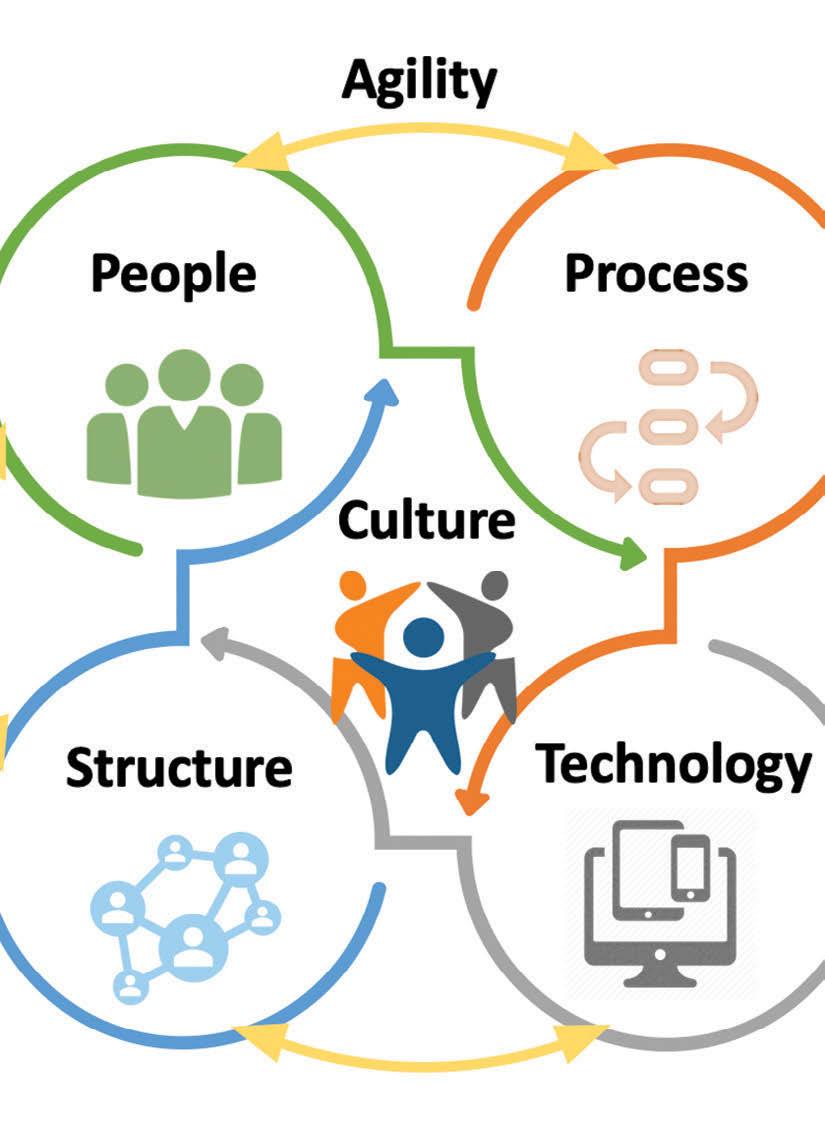
Continuous evaluation is the key to success.
Gone are the days of standing up a as people, process, technology and structure). This grand organizational design that assessment process will reveal key competencies functions for years. Enter the forever to replicate and ineffi ciencies to improve. Properly “beta phase” of ongoing nurtured by leadership, this process enhancement and becomes a transformative circuimprovement. The current pan- lar progression that, leaving demic has amplifi ed the con- no sacred cow untipped, trast in reaction time, or improves the organiagility versus the status zation’s agility and quo, more than any time effectiveness with in recent history. Now each new cycle. is the time to take action by embedding Refi ne your agility into your orga- vision nizational design. and your team.
Agility is not an People are your elusive concept, neither most valuable and, is it a disruptive, one- conversely, your time effort. Rather, it is a most unpredictable quantifi able system of con- resource. It is a result tinuous evaluation of your of humanness that you fundamental business practices. must install processes, The stepping-off point is an assess- technology and structure to ment of the core practices from which your ensure the correct actions are taken business culture emanates. That is, the standards and and completed accurately and on time. structure under which your people operate utilizing Most people want to do a good job for the formal and informal processes powered by rapidly company and customers and are often held back by changing technology tools (traditionally referred to the burden of status quo, a structure that is lethargic
Preston Herrin is a strategy, growth, and performance consultant. He has served in c-level and senior leadership roles at fast-growth companies like 4over LLC, Café Press, and Drummond. In his 30-year career Preston’s roles span strategy, business development and executive management providing e-commerce, software, logistics and service solutions for all vertical markets such as Manufacturing, Finance, Healthcare, Nonprofi ts and more.
and systems that are antiquated and time consuming.
Begin the transformation process by refi ning your company’s vision, mission and values to ensure they are compelling and aligned. The purpose is to set a standard and establish a culture that will generate a professional, productive and even emotional connection with your people. Then design an internal culture campaign that recognizes, encourages and rewards the embodiment of that culture. This will begin to wire your organization to respond to circumstances, and the inevitability of change, with an agile mindset.
Of equal importance to newly defi ned standards are the people in your company you engage to deliver on the spirit of the culture.
Leadership must cast a vision that will inspire the curiosity and performance of the team. Then do the hard work of objectively evaluating your team and their roles. It is common to rush this process and hire based on one-dimensional criteria. Hard skills alone are no longer the only measure. Soft skills like adaptability, communication, emotional intelligence and integrity are of paramount importance.
Build a thoughtful top-grading process within your organization and use it continuously. New people instill new ideas, which coupled with a new organizational design, will proliferate change throughout your business practices creating continuous improvement. Once initiated, the fi rst circular progression of creating agility begins to take hold.
Rethink processes and technologies.
Seth Godin, author, entrepreneur and genius marketer, said, “Organizations that destroy the status quo win. Whatever the status quo is, changing it gives you the opportunity to be remarkable.”
This thought gets to the heart of agile organizational design: your processes and enabling technologies must empower a nimble response to changing conditions in the marketplace. To accomplish this, create a recurring plan to engage your team and your strategic customers and partners to review your processes, workfl ows, automations and touchpoints. Empower your internal and external constituents to freely test your plan. You will get an objective, and possibly sobering, view of your actual business operating reality. Read More…
Equipped with a steady infl ux of Find article at feedback, take on the challenge to PrintingNews. rethink, redesign, replace and auto- com/21143596 mate operational processes on a continuous basis. Chances are you can list a dozen process and technology obstructions burdening your business delivery system. Your team and your customers can likely name twice that amount. Dedicate fi nances and human resources to the prioritization and delivery of progressive improvements. A key tactic is to leverage the surplus of simple, affordable SaaS solutions that can automate daily routines and create real-time visibility to information that used to take hours (or days) to compile.
As part of your culture campaign, close the loop by consistently communicating status updates to
Continued on page 63
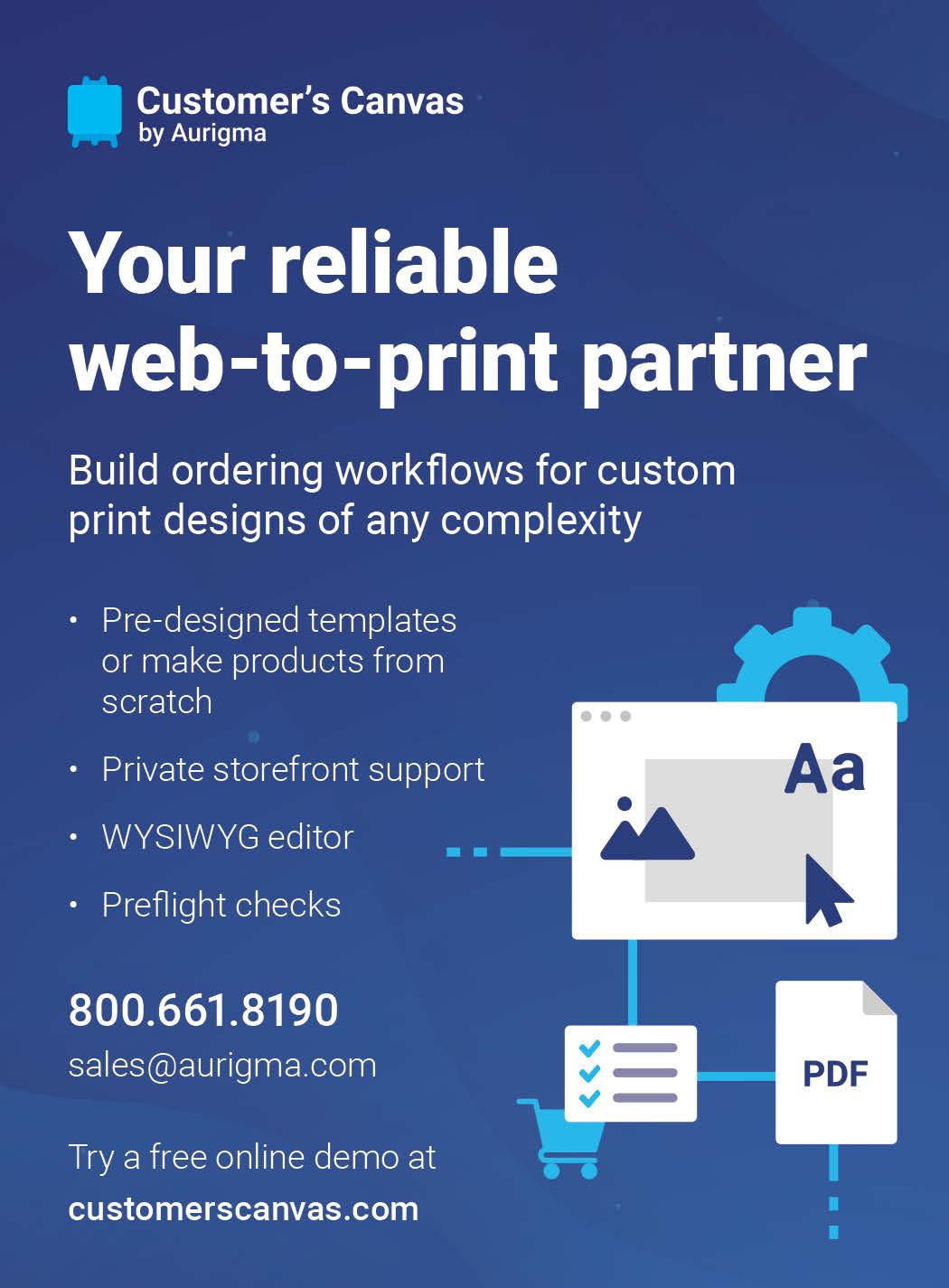
Crawford Technologies Announces Launch of CCM Gateway for Nuxeo

Crawford Technologies, provider of innovative document solutions that streamline, improve and manage customer communications, and Nuxeo, the developer of a leading content services platform (CSP), have joined forces to develop a new integration that will allow organizations to move their high-volume documents and customer service data, regardless of format, into the Nuxeo ecosystem. CCM Gateway for Nuxeo is the only solution on the market today that integrates Crawford Technologies’ transformation, indexing and document classifi cation techniques with Nuxeo’s robust cloud-native platform. The solution makes it possible for enterprises to move from problematic legacy storage systems to a modern, cloud-based, natively web-enabled solution to accelerate digital transformation initiatives.
www.printi ngnews.com/21143792
BOBST Brings Gravure Printi ng for Flexible Packaging into the Digital World with oneECG Extended Color Gamut Gravure Technology

Gravure is a printing process that has been spoken of relatively little of late, compared with other printing methods that have undergone a very fast transformation. However, the demands of the fast-moving consumers good industry have been pressing on gravure printing just as much: increasingly short run production and time-to-market, packaging customization, ready to recycle packaging substrates and the need for global brand color consistency.
Global color consistency is a conformity that brand owners aim to achieve on a global scale because when it comes to their favorite brands, consumers tend to perceive the lack of color consistency as a product quality issue. Therefore, printers and packaging converters must be equipped to deliver on this request and the adoption of the Extended Color Gamut (ECG) technology is one of the essential conditions.
www.printi ngnews.com/21143800
Core Publishing Soluti ons Expands into FourColor Digital Inkjet Producti on

Core Publishing Solutions announced the installation of new web press printing technology to provide its customers with high quality inkjet color printing at an affordable cost in multiple trim sizes.
Now Core Publishing Solutions’ customers can benefi t from one of the printing industry’s most productive inkjet color duplex presses, the HP T490 Pagewide Web Press, which attaches in-line to a Muller Martini SigmaLine III and has imposition and job optimization by Connex workfl ow software. This new press will join two already installed HP T360 inkjet presses at Core Publishing Solutions’ facility in Eagan, Minnesota. Core Publishing Solutions is one of the top 10 book manufacturers in North America .
www.printi ngnews.com/21143799
HP Launches The World’s Easiest Plott ers for Architect, Engineer, Constructi on and Home Offi ces
The new HP DesignJet series comprises intelligent, fl exible, compact and stylish printers, that are unique to other types of plotters on the market today. With HP Click software, oneclick printing – even for documents of different sizes – is made easy. Combined with the automatic A3/B tray, it enables to print multi-size projects automatically – A3/B and A1/D or A0/E – without manually switching the media source. The new HP DesignJet series also enables seamless printing and management from any connected device, wherever you are, thanks to the HP Smart App.
HP Inc. has announced the release of a new HP DesignJet portfolio aimed to simplify the printing needs of construction ecosystem professionals (architects, engineers, constructors and subcontractors), while delivering highquality and fast print-outs at a low cost.
www.printi ngnews.com/21143805
Quantum Design and Hunkeler AG Agreement Offers Game Changing Solution to Non-Stop Production in Digital Printing

Quantum Design has announced an agreement with Hunkeler AG. This agreement will make Quantum Design the exclusive supplier of automatic splicing and rewinding equipment for Hunkeler AG.
The partnership is a result of many months of hard work collaborating on a custom automatic splicing machine, the Hunkeler RS8 model, and an automatic turret rewinder, the Hunkeler TR8 model.
The technology that is central to this collaboration is a game changer for digital printing as Hunkeler will be offering the first inline finishing system with nonstop end to end processing in the industry.
The RS8 is a shaftless automatic butt splicer with two shaftless roll positions that feed a continuous supply of material into the press while the integrated storage festoon eliminates the need to stop for changing rolls.
The TR8 automatic turret rewinder is designed with two shafted roll positions to continuously rewind rolls directly from the press eliminating the need to stop the press to remove rolls and offering greater throughput.
Both machines feature touch screen PLC Controls and the quality construction for which KTI equipment is often recognized and that aligns equally with Hunkeler’s own equipment durability.
www.printingnews.com/21143845
Infigo Software Further Strengthens their Offering Through printIQ Partnership
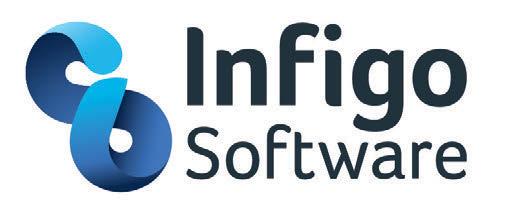
Infigo Software is proud to announce its further enhancements to the partnership with leading MWS provider printIQ - offering greater flexibility, efficiency and cost savings to its WebTo-Print customers.
With pressure on print facilities to create diversified revenue streams and improve productivity, Infigo is committed to building partnerships that enables clients to fully digitalize and futureproof their operations.
Through the dedicated integration with printIQ, Infigo’s users will benefit from a seamless, end-to-end estimating, ordering, and production workflow system.
The cloud-based management workflow system gives print managers complete overview of the workflow, so they can maintain continuity between stock suppliers, internal shop floor, right through to outsorcing.
Users can log in to the cloud-based system anywhere in the world, track jobs online and manage entire projects remotely - from estimating all the way through to invoicing. This enables printers to massively improve operation efficiency - from increasing quote response rate to reducing production errors.
www.printingnews.com/21143930
Barthel Gruppe Strengthens Environmental Offering with Worlds First EcoLeaf Metallization Unit on a Digital Hybrid Press
ACTEGA Metal Print GmbH announced that the specialist highquality labels printer, Barthel Gruppe – one of the largest labels printers in Germany and the Netherlands – has joined its beta program with the world’s first installation of an ACTEGA EcoLeaf Metallization unit on a digital and flexo hybrid press.
Recently installed on a Mark Andy Digital Series HD press, at its eprint facility in Bünde, Germany, the EcoLeaf unit enables the company to offer an alternative to traditional cold foil, while providing its cosmetics-based customers with high quality, cost effective but sustainable short to medium-run metallized silver labels. Additionally, by using the Mark Andy press to overprint the EcoLeaf trigger image, the Barthel Gruppe can now offer new forms of profitable decorative effects including a rainbow of metallic colors.
Barthel Gruppe – with headquarter in Essen, NRW – specializes in providing labels for some of the world’s leading brands in markets including chemicals and auto, food, pharmaceuticals, wine and spirits. In January 2020, Barthel Gruppe acquired the cosmetics specialist eprint to expand and complete its portfolio. The company now has printing and storage facilities across Central Europe, enabling it to successfully serve its worldwide customer portfolio.
www.printingnews.com/21143850
More Innovati on from Tom O’Brien: Flexible Packaging On Demand
Tom O’Brien, founder of AccuLink, now has a new business added to the mix called AccuFlex Packaging.
Find video here: www.printi ngnews.com/21143161


Target Report Interview—Buyers are On The Move and On Track
Rod Bristol talks with Mark Hahn of Graphic Arts Advisors about how M&A activity is different.
Find video here: www.printi ngnews.com/21143318

Frank’s Flashback: 1995
2020 marks the 25th anniversary of what was a watershed year for the printing industry. 1995 was the year that the industry was at its peak.
Find video here: www.printi ngnews.com/21143410 Pete Santora Shares Insight into the Future of Apparel Automati on
Pete Santora examines how automation can help reshore manufacturing and strengthen supply chains.
Find video here: www.printi ngnews.com/21143282


Michael McDonald Shares Insights on Sewn Products
Michael McDonald, President of Sewn Products Equipment and Suppliers of the Americas (SPESA), provides information on the organization.
Find video here: www.printi ngnews.com/21143370
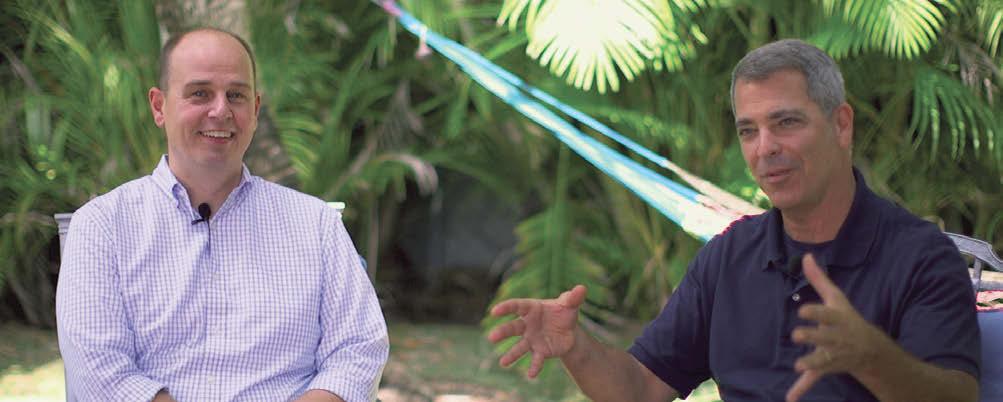
thINK Conference Goes Virtual
Canon Solutions America EVP Francis McMahon and and thINK Executive Director Eric Hawkinson, preview the sixth annual thINK Ahead conference.
Find video here: www.printi ngnews.com/21143501
thINK Board Members on This Year’s Event
David Zwang talks to thINK Board members Todd Roth and Pete Studer about how the Board made the decision to hold thINK as a virtual event.
Find video here: www.printi ngnews.com/21143545

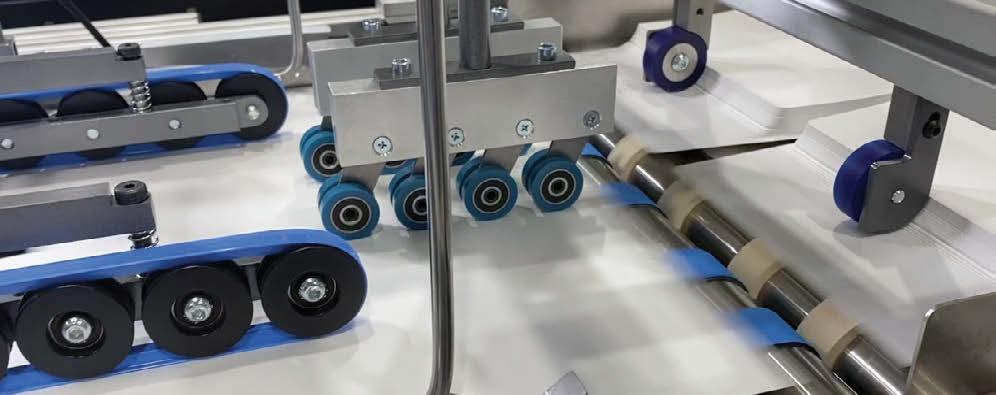
Advantage CS-25 running pocket folders 7,000/hour
ALL NEW Rollem Advantage line of converting system, shown fi nishing a 9 x 12” pocket folder. The folder was die cut on an Insignia die cutting system.
Find video here: www.printi ngnews.com/21143597
Industry Veteran Aviv Ratzman Founds Compack, a New Web-to-Pack Portal
Aviv Ratzman, who spent time at HP Indigo and cofounded Highcon, starts a new venture today.
Find video here: www.printi ngnews.com/21143710


Sewing Automati on: Where Are We Now and Where Are We Going?
Frank Henderson of the Henderson Sewing Company is the third generation running this family business.
Find video here: www.printi ngnews.com/21143812
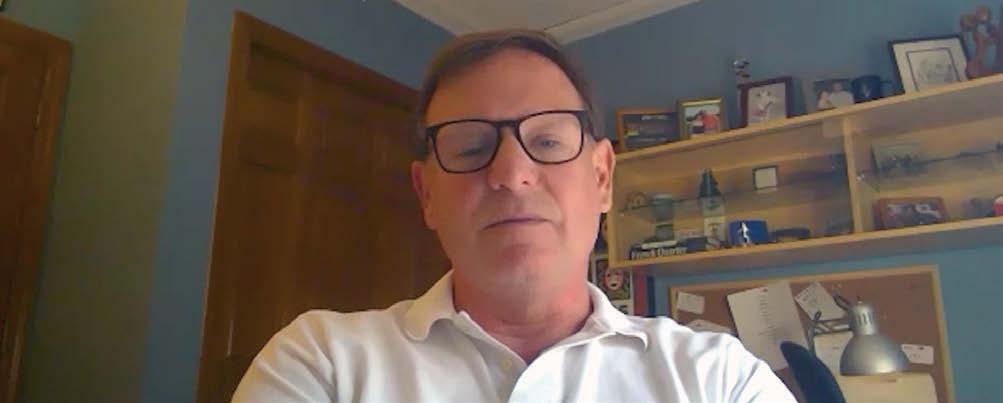
Att racti ng New Talent: A 2020 Imperati ve
Jeff White, Director of Development for the Print & Graphics Scholarship Foundation (PGSF), provides an update on the status and activities of the organization.
Find video here: www.printi ngnews.com/21143990
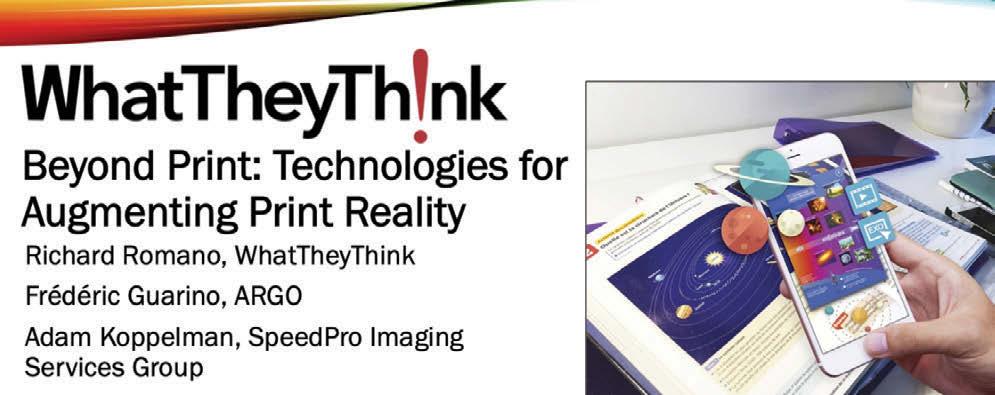
Beyond Print: Technologies for Augmenti ng Print Reality
Industry professionals and business owners and managers registered for WhatTheyThink LunchNLearn Webinar.
Find video here: www.printi ngnews.com/21143587 Warren Werbitt Goes Printer to Printer with Jubels’ Jeroen van Druenen
Warren Werbitt talks to Jeroen van Druenen, CEO of 80-year-old Jubels in Amsterdam.
Find video here: www.printi ngnews.com/21143752


AI/DC: I made a bot write an AC/DC song
Using lyrics.rip to scrape the Genius Lyrics Database, I made a Markov Chain write AC/DC lyrics. This is the end result- “Great Balls”.
Find video here: www.printi ngnews.com/21143858
Mohawk Paper’s Chris Harrold Explains the Renewal Line of Papers
Mohawk Paper has introduced its Renewal line of papers. It is using hemp and straw fi bers in two paper lines.
Find video here: www.printi ngnews.com/21143916
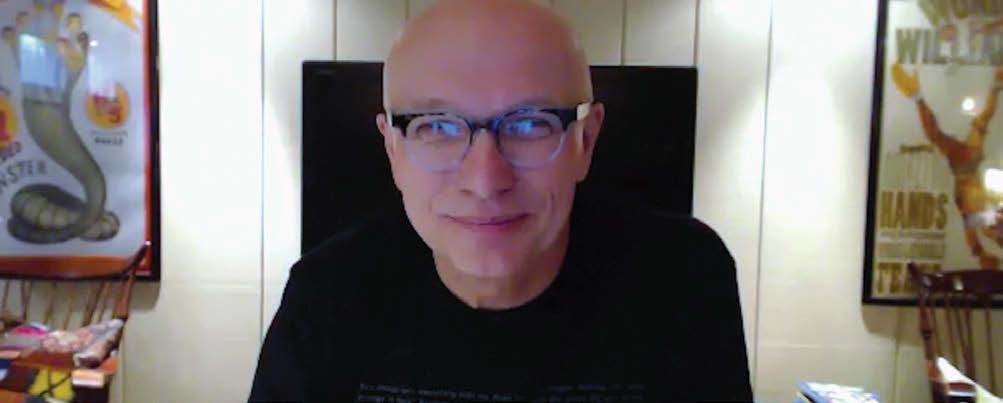
Canon Responds to the Pandemic
Canon Solutions America EVP Francis McMahon and and thINK Executive Director Eric Hawkinson talk about how the company responded to the pandemic.
Find video here: www.printi ngnews.com/21143589










